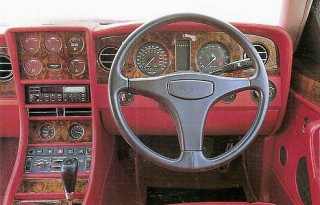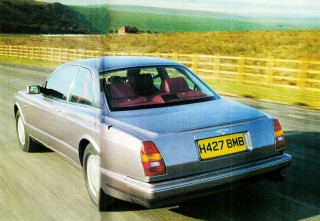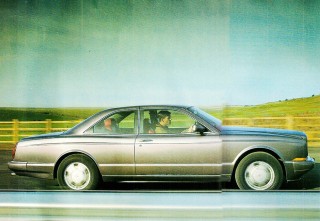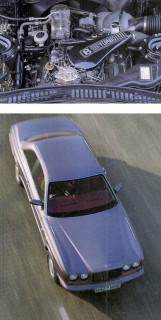Last time Rolls-Royce Motors built a coupe we got the Camargue, the lumbering result of an ill-advised liaison between Crewe and Pininfarina that produced a vehicle both ugly and rare, and in view of the former we should be grateful for the latter. There’s no need to feel that way about the new Continental R. which is vastly better proportioned, drives like a coupe should, and has enough thrust to disabuse anyone of the notion that it’s just a jumped-up drawing room on wheels.

Of course, a Bentley Turbo R is a drawing room on wheels, too. one that happens to be capable of launching itself, rather Improbably, to 60mph in no more than 6.6 seconds and on to a top speed of 145mph. Since the Continental R is essentially a rebodied Turbo R. the question here is how this big Bentley Coupe can be a better sporting car than a big Bentley saloon.
There’s certainly no point in asking how it stacks up against the rivals – if you can find any, the answer is expensively and not well enough to warrant the extra money. Not if you’re going to be sensible about it anyway. And for the record, the Continental R costs £175.000, enough to make it an irrational purchase in anybody’s book.
But the point of a car such as this is the experience it delivers, and whether it’s special enough to make Someone Who Is Very Rich think it worth shelling out for. The Continental is certainly imposing enough for those who wish it to be known that they have spent a great deal of money. It may look less bulky than the saloon, but it’s actually almost three inches longer and an inch and a half wider. The only dimension to have shrunk is the height, if only by less than an inch. The illusion that there’s less bulk stems from the two- door styling. Actually, there is fractionally less mass, the Continental weighing 5340lb, 30lb less than the Turbo R.
Climb inside – and you do climb, because this is no low-slung Coupe – and it’s easy to see where much of the weight is. because here is one opulent cabin. No medals for guessing that it draws heavily on natural materials – several mooing quadrupeds and not a little arboreal vegetation was sacrificed to produce this extravagant cocoon.
Though some of the contents will be familiar, the architecture of this room is unique to the Continental. Perhaps most obvious is the angle of the windscreen, which seems daringly rakish compared with that of a Turbo R. Then there’s the dash, a leather-topped bank of walnut into which seven dials and four massive chromium air vents are sunk.
Dropping from its centre is a long, broad console that dips and heaves the full length of the cabin to bisect the rear seats, where it halts in a black swathe of leather at headrest height. If nothing else, this structure rams the message home – the Continental is a four-seater, and nothing more.
So those banished to the back get individual scats instead of a rear bench. There’s ample room, though, even if fatter brogues won’t quite snuggle beneath the chairs in front. Nor is there much in the way of gadgetry to enhance life back there. No fresh air vents for example, nor any form of seat adjustment, something even the humble Granada Scorpio can offer. Given the Continental s £175.000 price tag. one could almost claim to be hard done by.
Two-door Bentley is actually three Inches longer and an Inch and a half wider than a Turbo R. Acceleration Is helped by shorter gearing. Interior la gloriously comfortable and opulent It’s a strict four-seater.
No-one who sat up front could voice that gripe. Each occupant gets to fiddle with a pair of those gloriously tactile air vents and their organ-stop knobs, can adjust their seat every which way and enjoy the subtly gusting ministrations of an air conditioning system that costs more than a Metro. Mind you. even that does without me sophistication of affording side-to-side variations in the climate.

Those new to the Bentley will be more struck by the thought that its cabin atmosphere reeks of nostalgia, a theme which is perhaps carried a little too tar when you discover that the wipers are still triggered by a twist-action knob on the facia. Admittedly it’s a beautifully wrought item in satin chrome, but this is hardly an ergonomic solution of the ’90s. Still, there’s no denying that Bentley has departed the ’50s when it comes to gear-changing arrangements, which are now triggered by a stick shift on the centre console rather than via a lever sprouting from behind the wheel. In fact, the redundant shifter lives on, to house the cruise controls.
There are tales of Rolls test drivers grasping said shifter and wrenching it till it bends in the effort to engage a gear, a memory lapse that’s only going to afflict those who regularly drive the saloons. The point of the relocation is to enhance the sportiness of the car, a campaign that has produced front seats that aren’t totally flat, a 170mph speedometer, an oil-temperature gauge and a three- spoke steering wheel that has passed chrome and bakelite by – instead, it’s upholstered in taut black leather, and it’s a pleasure to clench.
Not that it has to be gripped hard to steer this leviathan. Swivelling it is more than a job for a single forefinger, but it doesn’t take much effort to effect a direction-change. It doesn’t take much effort to conduct the Continental at ail in fact, a quality it has in common with its saloon brother. The biggest problem is that it’s… well, big and it takes a while to get accustomed to the extent of the bulk that you’re manoeuvring. But not as long as you might think. It’s fairly easy to sec out, the driving position places your eyes high and. as the clich6 goes, the boast seems to shrink around you. Best not to let it shrink too far in the mind’s eye, though, else life could get expensive.
Part of the reason for your being able to place it confidently stems from the fact that you can see much of the metalwork beyond the glass. In particular, you enjoy a fine view of a gently swelling bonnet that’s redolent of the grand tourers of old. There are quite a few subtle curves in the shape of this car, which sees a return to the coke-bottle style of the late ’60s and early ‘70s.
The Continental’s styling is largely the work of Ken Greenley and John Heffernan, they of Panther Solo and Aston Martin Virage fame, and is the end result of an exercise that began with Project 90 six years ago. Project 90 was a Bentley Coupe design exercise revealed at the Geneva Show in 1985. the point being to determine what interest there’d be in a Bentley coupe. And the answer was that there was plenty of interest in the principle, but as Ken Greenley says. ‘The company got a confused message, because there was a positive response from Germany and the US. but a less good one in Britain.’ The confusion produced a delay while Rolls-Royce deliberated, though it was gradually tipped in favour of the project as sales of 8entleys mushroomed on the strength of the remarkable Turbo R. But it wasn’t until 1987 that the Heffernan and Greenley team set to work on the car, this time codenamed Nopal.

The two were housed in the Mulliner Park Ward factory at Park Royal, north London (recently closed down, sadly) where they could stay in regular contact with Rolls-Royce engineers and avoid the risk of the not-invented-here syndrome undermining the project. The late Fritz Feller, designer of the Silver Spirit, described the arrangement as ‘design by artificial insemination’, according to Greenley, who. like his colleague, was very anxious to absorb enough of the Rolls and Bentley culture to feel confident that they were taking the design in the right direction.
The duo reckon this arrangement worked well. ‘The great thing about working with Rolls-Royce.’ says Greenley. ‘is the deep enthusiasm there is for the product. Even the financial people have strong opinions. We felt part of the Bentley team, something I never felt with Aston Martin.’
Greenley explains that the hard points of the design, the immutables, were determined early on. and the most fundamental was that the height of the bulkhead should not change relative to that of the Turbo R. upon which the coupe is based. ‘That makes a lot of sense,’ says Greenley. ‘There’s a lot of real estate south of the bulkhead, and it’s expensive to change.’ But there was plenty of scope for departing from the Turbo R menu in other areas.
For instance, a mere reskin would have demanded that all the seat reference points remain unaltered, but in this instance the pair were free to change them, which they did, along with the steering column angle.
Says Greenley, ‘The person who signs the cheque for a Rolls-Royce tends to sit in the back of the car, but the driver package is much more important in a Bentley. Since the seat is already close to the floor in these cars because of the lack of a sill, the angle of leg to pedals is already quite sporty. But we wanted to provide more front legroom so that there’d be thigh contact with the seat for better support, which in turn called for the steering column to be slightly repositioned. It meant more of a compromise in the back, but there’s still adequate room. And making a four-seater coupe was a priority.’

Though Greenley and Heffernan planned the car’s interior package, it was Rolls’s own Graham Hull who was responsible for the interior, which was developed around the theme of the full-length centre console. Greenley reckons Hull and his team were undoubtedly best equipped to do the job, because they’re familiar with the materials and traditions that go to make up a cabin such as this.
Though the Continental is a low-volume model. Rolls wanted to build it on the same production lines as the saloons, which meant there was little scope for hand-finishing the body-in-white. The upshot is a shell that’s made entirely off tools, to a standard high enough to avoid the need for any lead loading to mask imperfections. That meant a substantial investment-around £8 million for the body, and almost half that again for the various engineering changes – and no scope for major changes once the full-size clay was measured for the tooling using computer- aided design, the first time such techniques had been used for this process at Crewe.
Not that the shape has changed much from the original Heffernan and Greenley proposal. “We knew we wanted vertical roar tail-lights from the start,” says Heffernan. ‘because they’re a traditional feature of British cars such as this, and the rake of the screen was more or less predetermined for packaging reasons – we had to retain the existing bulkhead, and the 61-degree inclination is as far as you can go before the top of the screen might be perilously close to a swinging head in a front-end accident.
There was an experiment to completely rid the car of chrome, but it didn’t look right – the jewellery, as Rolls calls it, of a car such as this is very important, which is why there’s a pair of laser-cut chromium tail- light bezels at the back end. Tooling-up the rear lamp clusters, incidentally, cost £350.000-£400.000.
Some things that did change, however, wore the headlamp treatment and the shape of the boot lid. Spend more than a few seconds looking at the Continental’s front end and it’s not hard to imagine the rectangular headlamps that were originally intended to sit there. But as the project progressed so did Bentley’s reputation, and the four- headlamp style of the Turbo R began to be seen as something of a motif. So it wasn’t hard to make the decision to use the same approach for the coupe, particularly when unique headlamps cost a fortune to tool up. whereas the seven-inch round lights are straight off the shelf. And round lights. Heffernan points out, work better than square ones.
The boot lid changed for aerodynamic reasons. Apart from lowering the Cd. down from the appalling 0.45 of the Turbo R to an adequate 0.37 for the Continental, an aim was to reduce lift, and it was found that the rake of the rear screen and the shape of the boot lid were critical here. That’s why the boot lid bears that curious lip as it curves down to meet the rear bumper, a feature that adds to the car’s distinctiveness.
Rear tail-lamps are vertical, and traditionally British. Unusual boot Iid shape helps aerodynamics. Driving environment is traditionally Rolls, although gearlever is now on centre console, not column. Auto is four-speed.
A further aspect of the aerodynamic work was the quest to ensure that the car’s centre of pressure remained well forward under a variety of angles of yaw, a critical factor for stability in cross winds.
It was an improved aero performance that was originally to be the solo source of the Continental s performance advantage over the Turbo R. Since then, two things have happened. First, it comes with a four-speed auto box rather than the three-speed of the saloon (though the saloon will soon be so equipped, too), and changes in gearing have made it still more of a sprinter. Secondly, we know that, eventually. Rolls’s new sister company Cosworth will yield it a pair of four-valves-per-cylinder heads to plant aboard the old V8 block. But that won’t happen for a while.

For now, the Continental owner must be content with the four-speed auto, its gears effectively shortened because the rear axle has also changed. Apart from this, bigger wheels, lower-profile tyres and slightly stiffer from suspension, the Continental is mechanically identical to its saloon progenitor. Despite this, the ratio changes shave one and a half seconds off the 0-100mph time, which the Conti can knock off in 16 seconds. And believe me, that is blisteringly swift.
You’re not unaware of the fact, even within the first few feet of a drive. A light brush of the throttle will see the car surge forward, radiator shell rising a shade as the torque is sent to the floor, the V8 burbling faintly in the background. A more ambitious prod will send heads rearwards, yours and your passengers’, until neck muscles stiffen to check their tilt, and the coupe lunges forward.
Just like the Turbo R, it accelerates with an alacrity that astonishes, it just doesn’t seem possible that a car so big and so heavy can rocket ahead as instantly and eagerly as a Peugeot 205 GTI. But it can, and it’ll bring on a grin, just like the Peugeot does.
Not that the power is quite as accessible as in the Turbo R, because there are moments when kicking into third from fourth is needed for rapid manoeuvres, a time-wasting process the three-speeder obviously avoids. The problem is obviated to some extent by pressing the S for sport button atop the gearlever, which produces kickdown more readily and holds the lower ratios for longer, though it’s rare that you’ll have the space to get near the lowly 4500rpm red line – even in second, the V8 will pull 70mph.
However, there’s an unfortunate corollary to pressing that S for sport button, and it’s one to disturb your equanimity, because triggering it stiffens the responses of the electronic adaptive dampers, now standard fare on all Rolls-Royces and Bentleys since last year. It’s a pity that the two strategies are inextricably linked, because the ride, already on the firm side, does not need to turn any more resistant.
You can’t say the Bentley rides badly in absolute terms, but it does for its price. The stiffening only occurs at lower speeds, dramatically increasing the suspension’s percussive qualities – the bump, thump and crash of overtaxed hardware – without dramatically improving the car’s agility. It’s agile enough already in truth, cornering with remarkable aplomb.

In fact, you can throw this car around if there’s the space. The steering isn’t super-quick, and it could do with more weight during those press-on moments, but it’s accurate and responsive, with none of the slop that you’d expect of a barge such as this. Nor is there much roll (whether you’re in sport or not), and the bolstered seats banish the slip and slither problems you’d encounter in the saloon. No longer does the wheel have to double as a lifebelt for the driver who’s all at sea.
Which makes the ride deficiencies all the more noticeable. Even out of sport, the ride isn’t too hot. The chairs don’t shiver and shako over big bumps, like they do in the Turbo R, probably because of the extra stiffness in the shell – two fewer gaping holes for doors must help here – but there were creaks and rattles from the trim of this car, and a fair bit of jarring through the suspension.
Admittedly our sample was a prototype, number four in fact, and there’s no doubt that the trim will be more solidly attached in production versions, but save for a seven-percent stiffening to the front springs, the running gear is exactly as it is for the Turbo R. So there’s no improvement likely on that front.
But let’s not get this out of proportion – the Continental may not cushion its occupants as completely as a £175.000 car should, but the problem doesn’t seriously obstruct your enjoyment of it. In other departments it’s fabulously smooth, the V8 woffle creamily apparent only that high revs, the transmission shifting near seamlessly, you’ journey slicing by with delicious ease.
And though we didn’t drive it for long enough to find out for sure, there’s every hint that the Continental has the stability to make 145mph cruising a relaxing business. That would be a higher figure but for the fact that the maximum speed is limited by a boost control the top speed of the unlimited Continental test cars is said to be over 160mph. Which must make quite a sight in the rear-view mirrors of lesser machinery.
And in the eyes of some, that will be just about everything else on the road. But the Continental’s not that good, though it’s very good indeed. It doesn’t have the depth of ability of an S-class Mercedes-Benz W140, and will be embarrassed in many areas by the new SEC (C140 1992 MB) when it comes. As we’ve said often enough before, though. Bentleys have a charm and character that transcends drawbacks such as this, and completely enough to make them a justifiable alternative. There’s no car to give you the experience of the Continental R except a Turbo R, and the coupe has considerably more grace.
It’s hard, though, to expunge the thought that the Turbo R is more fun to drive because its performance teats seem more improbable. You do not expect a hulking great limo to hit 60mph in 6.6 seconds and corner like a GTi. To experience the same thing in this coupe doesn’t seem as remarkable, somehow, even if the physics of the beast – its weight, its size – make its performance just as much of a feat. But that’s hardly going to stop people wanting it, as a two-year waiting list proves.
Car impressively stable at speed, but ride is a little disappointing, not helped when sports suspension activated. Note ‘coke bottle’ styling. Engine is pushrod 6.75-litre V8, carried over from the Turbo R saloon.





